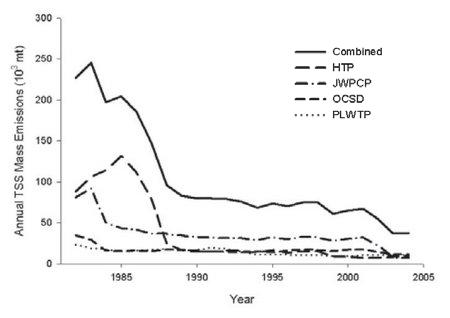 Research Areas > Contaminants > Characteristics of Effluents from Large Municipal Wastewater Treatment Facilities
Research Areas > Contaminants > Characteristics of Effluents from Large Municipal Wastewater Treatment Facilities
Project: Characteristics of Effluents from Large Municipal Wastewater Treatment Facilities
Background and Objective
Pollutant mass emissions from the four largest publicly owned treatment works (POTWs) in southern California have historically been the largest source of contaminant inputs to the Southern California Bight (SCB). However, contaminant loads from these sources have declined over the last 30 years as a result of increased effluent treatment, source control, industrial pretreatment, and reclamation.
This project characterizes each of the POTW’s effluents based on their discharge monitoring reports. Each year, calculations are done to estimate mass emissions. This information is added to SCCWRP’s database, continuing a time series dating back to 1972.
Map showing location of four largest POTW outfalls in Southern California.
Status
This is an ongoing project.
Methods
On an annual basis, SCCWRP compiles the most recent annual monitoring reports from the four largest Southern California POTWs (City of Los Angeles Bureau of Sanitation, Sanitation Districts of Los Angeles County, Orange County Sanitation District, and City of San Diego Metropolitan Wastewater Department). Values are entered into a database, where concentrations for a variety of constituents are standardized to monthly time steps. Each discharger’s monthly flow data and constituent concentrations are then used to calculate annual discharge volumes and mass emissions. SCCWRP uses this data to investigate emerging and ongoing trends in POTW discharges.
Findings
Large POTWs in southern California discharge over 500 million liters/day to the SCB. A comparison of mass emissions data between 1971 and 2000 showed that, by volume, large POTWs account for about half of total discharge. Other discharge sources include stormwater, small POTWs, power stations, industrial facilities, oil platforms, and dredged material disposal. Large POTWs remain a primary source for about 15 out of 24 monitored constituents. However, major reductions in mass emissions have occurred for most of these constituents, including suspended solids, oil and grease, phosphorus, metals and DDT. These changes are attributed to improvements in wastewater treatment. Emissions have also declined (to a lesser degree) for nutrients such as nitrate and ammonia. When compared to data from the Bight Regional Monitoring Programs, concentrations of metals in the sediments surrounding large POTW outfalls have likewise decreased, following the trend of declining effluent concentrations.

Trend in annual mass emissions of total suspended solids (TSS) from large POTWs between 1982 and 2004.
The most recent data from 2005 to 2009 indicate total effluent volume from large POTWs decreased to the lowest annual volume since regional assessments began in 1971. These reductions in effluent volume resulted primarily from water conservation and increased recycling of treated effluent for beneficial reuse, even as population continued to grow. Similar to the volume pattern, mass emissions of most monitored constituents decreased from 2005 to 2009, with many constituent loads including suspended solids, BOD, oil/grease, and several metals dropping to historic lows. Recent reductions in loads have been influenced more by declining effluent volume than by improvement in effluent quality, though, and average concentrations of several constituents including ammonia- N, chromium, and zinc increased from 2005 to 2009.
Partners
City of Los Angeles
Sanitation Districts of Los Angeles County
Orange County Sanitation District
City of San Diego
This page was last updated on: 7/1/2014